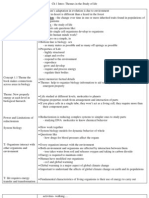Business Is War
Business Is War
Uploaded by
rinkyrajputCopyright:
Available Formats
Business Is War
Business Is War
Uploaded by
rinkyrajputOriginal Title
Copyright
Available Formats
Share this document
Did you find this document useful?
Is this content inappropriate?
Copyright:
Available Formats
Business Is War
Business Is War
Uploaded by
rinkyrajputCopyright:
Available Formats
Business As War
By: Mark B. FullerOctober 31, 1993
Business in the New Economy is a civilized version of war. Companies, not
countries, are battlefield rivals.
In Clausewitz's terms, the era of "set-piece" competition is over. We have entered the era of total
competition. No matter your industry, company, or nationality, there is a battle-ready competitor
somewhere who is busy thinking how to beat you. There are no safe havens.
Yet the hard truth, for all the talk of new paradigms, reengineering, and organizational learning, is that
most executives in most companies are still equipped to fight the last war. Their strategic assumptions,
management structures, information systems, and training programs are geared to a competitive
battlefield that no longer exists. The rules of engagement have changed. Strategic mind-sets have not.
In the life-or-death quest for strategic change, business has much to learn from war. Both are about
the same thing: succeeding in competition. Even more basic, both can be distilled to four words:
informed choice/timely action. The key objective in competition - whether business or war - is to
improve your organization's performance along these dimensions:
• To generate better information than your rivals do
• To analyze that information and make sound choices
• To make those choices quickly
• To convert strategic choices into decisive action
Together they represent informed choice/timely action.
Why Companies Fail
It's no secret why companies fail. The failure starts at the top. CEOs and their senior executives know
the problems; in fact, in the privacy of their offices, they'll volunteer them to you.
"We have the information in the company. But we don't seem to get it to the right place."
"We get the information to the right place. But then we can't seem to make the choices we should."
"We're okay at choosing what to do, but we're too damned slow. By the time we pull the trigger, the
target's moved."
"We know what needs to happen. But we never seem to execute. I never see action."
For some companies, the list of symptoms includes bad habits that slowly erode performance: rivalries
in the executive suite, endless turf consciousness, resource struggles between business units. In
short, functional boundaries drive a wedge between managers who should be on the same side but
who act like the Army, Navy, and Marines competing to see who leads the invasion. In these cases
you hear sentiments like, "We can't pull together, we're always pulling separately. There's too much
internal friction around here."
In every struggling large company I've seen, the symptoms are the same. It's all just a matter of where
it hurts worse.
Why Companies Fail, Part 2
It's no secret why companies fail. They fail because over the last 20 years they have been taught to
fail. Think of it as Joe Stalin Visits Corporate America: "We have a five-year plan. The five-year plan is
in a three-ring binder. The three-ring binder is on a shelf in the CEO's office. The five-year plan sets
goals. We will meet or exceed those goals."
In this all-too-familiar model, the pieces of the company and the pieces of the strategy are broken
down into separate elements. Line is separate from staff. Market research has nothing to do with
product positioning. There's no connection between strategy and operations.
Companies then decompose pieces of their strategy into separate projects and assign them out to
different people in different places - people who have never worked together, never even met each
other. In fact, these people were hired, promoted, motivated, and rewarded in ways that trained them
not to like each other, not to trust each other, not to help each other, not to speak to each other. They
were trained not to work together.
In this respect, right through the Vietnam War, big companies and the military shared much the same
approach to strategy. Both labored under institutional dynamics that virtually guaranteed competitive
defeat. The terrible irony of Vietnam was that the United States won every battle but lost the war. Most
military histories of the Vietnam War agree on the reason for defeat: the military had no unified
strategic doctrine, no clear definition of victory.
American business had its Vietnam 10 years after the Pentagon did. In the 1980s, one company after
another confronted agile domestic competitors and new global rivals. These "guerrillas" exposed the
flaws of business-as-usual. Like the Pentagon, business learned its lesson the hard way. Now it must
learn to change.
Carl von Clausewitz: Business is War
"Rather than comparing [war] to art we could more accurately compare it to commerce,
which is also a conflict of human interests and activities; and it is still closer to politics,
which in turn may be considered as a kind of commerce on a larger scale." On War, Book
I, Ch. 3
"Business is war. Arm yourself." Motoman 2-page ad in Manufacturing Engineering,
August 1994.
Mission Statement
Clausewitz.org is about putting the principles of history's greatest leaders and
organizational developers to work in the modern workplace. Levinson Productivity
Systems, P.C. offers management consulting services that can make these principles work
for your organization.
Overview
War is the oldest form of competition between human organizations; business is a
relative newcomer. There were no large business organizations (with a few exceptions,
like Britain's East India Company) until a couple of centuries ago. Humans have been
fighting wars for millennia and war has driven the evolution of techniques for organizing,
supplying, leading, and motivating large numbers of people.
The idea of quality management systems, or mutually supporting and synergistic
activities that make sure "things go right," is but a few decades old. The ISO 9000
standard for quality systems is, as of 2000, less than a decade old. The harshest possible
environment, one in which not only natural forces but the opponent is trying to cause an
organizational system to fail, drove the evolution of military organizational systems.
Many aspects of these systems are adaptable to civilian activities.
History's greatest generals may or may not have been outstanding strategists and
tacticians but they were always outstanding organizational developers. Two of the
greatest commanders who ever lived, Alexander the Great and the Russian field marshal
Alexander V. Suvorov (1729-1800), created or improved outstanding organizations.
Alexander's father Philip II developed the Macedonian Army into a highly professional
fighting organization. Philip's innovations included drills, logistics for rapid movement,
and equal discipline for officers and enlisted troops. Alexander maintained this system,
and his personal behavior earned the commitment of his troops.
• Frederick William I left his son, Frederick the Great, a superbly-trained army. As
these soldiers suffered attrition through battle or retirement, Frederick's ability to
win declined. Although Frederick was a skilled tactician and strategist, he was not
a great organization-builder.
Suvorov encouraged self-direction and innovation by enlisted soldiers in an era when
commanders relied on tight control: Taylorism before Frederick Winslow Taylor.
Suvorov's leadership, like Alexander the Great's, promoted outstanding commitment,
morale, and enthusiasm.
Intellectual Heritage of Clausewitz.org
Every thoughtful man has an idea of what ought to be; but what the world is waiting for
is a social and economic blueprint. …We want artists in industrial relationships. We want
masters in industrial method, both from the standpoint of the producer and the product.
We want those who can mold the political, social, industrial, and moral mass into a sound
and shapely whole.
--Henry Ford, Ford Ideals (1922)
Quoted in the Preface to Levinson, 2002, Henry Ford's Lean Vision: Enduring Principles
from the First Ford Motor Plant (Productivity Press).
Through the travail of the ages,
Midst the pomp and toil of war
Have I fought and strove and perished
Countless times upon this star.
In the forms of many peoples
In all panoplies of time
Have I seen the luring vision
Of the victory Maid, sublime.
I have known the call to battle
123456next ›last »
From Issue 00 | October 1993
You might also like
- George Antone - The Debt MIllionaireDocument145 pagesGeorge Antone - The Debt MIllionaireFederico CasellaNo ratings yet
- The Bankers Bible - 2021A - Sep - R1Document60 pagesThe Bankers Bible - 2021A - Sep - R1brianchen1993No ratings yet
- ThingsTheRichDon'tWantYouToKnow NoahKaganDocument59 pagesThingsTheRichDon'tWantYouToKnow NoahKaganpbaranowski14No ratings yet
- Virgin Media Case Study Questions WorksheetDocument2 pagesVirgin Media Case Study Questions WorksheetRiaz Attrash0% (2)
- Mergers and Acquisitions Strategy for Consolidations: Roll Up, Roll Out and Innovate for Superior Growth and ReturnsFrom EverandMergers and Acquisitions Strategy for Consolidations: Roll Up, Roll Out and Innovate for Superior Growth and ReturnsRating: 3 out of 5 stars3/5 (2)
- Anna Riva - Devotion To The SaintsDocument111 pagesAnna Riva - Devotion To The SaintsAradialevanah86% (7)
- Winning, by Jack WelchDocument19 pagesWinning, by Jack WelchMuhammad Salman ArshidNo ratings yet
- Joint Venture (JV) ContractDocument3 pagesJoint Venture (JV) ContractGabe Coyne100% (2)
- How To Think Like A Tycoon WG HillDocument203 pagesHow To Think Like A Tycoon WG Hillgalt67100% (2)
- WWW Reddit Com Search Q Toastmasters 20book PDFDocument3 pagesWWW Reddit Com Search Q Toastmasters 20book PDFabdah liadara0% (2)
- QLAeBook 2ndeditionDocument39 pagesQLAeBook 2ndeditionMK Career Solutions100% (1)
- Drexel 10 Yr RetrospectiveDocument41 pagesDrexel 10 Yr RetrospectiveDan MawsonNo ratings yet
- Americas Hidden Depression - dsj747Document9 pagesAmericas Hidden Depression - dsj747ChrisLCampbellNo ratings yet
- James Maverick - The Sovereign ManDocument411 pagesJames Maverick - The Sovereign ManEdmond100% (1)
- Surplus Pro Pack Bundle 2023 (1) (2)Document156 pagesSurplus Pro Pack Bundle 2023 (1) (2)jhonsonjeannoelNo ratings yet
- The Entrepreneurs Roadmap PDFDocument321 pagesThe Entrepreneurs Roadmap PDFana_ciNo ratings yet
- The_QLA_7-Steps_Deep_Dive_Boot_Camp_-_Week_One_-_FinalDocument19 pagesThe_QLA_7-Steps_Deep_Dive_Boot_Camp_-_Week_One_-_FinaltontinedatoNo ratings yet
- Checklist and Formats For RIADocument8 pagesChecklist and Formats For RIAbhavesh kalalNo ratings yet
- 17 Fundamental Principles of Law of Success 27 PagesDocument27 pages17 Fundamental Principles of Law of Success 27 PagesRafael Aleman100% (2)
- Puerto Rico Capital Fund, LLC.Document84 pagesPuerto Rico Capital Fund, LLC.Marc BaronNo ratings yet
- Rob Slee TENS 4-16-2012Document20 pagesRob Slee TENS 4-16-2012TENS_webmasterNo ratings yet
- Sovereign Man ConfidentialDocument42 pagesSovereign Man Confidentialivesti37950% (4)
- The Power of TrustDocument1 pageThe Power of Trusttsudhakar99No ratings yet
- The_QLA_7-Steps_Deep_Dive_Boot_Camp_-_Week_Two_-_FinalDocument29 pagesThe_QLA_7-Steps_Deep_Dive_Boot_Camp_-_Week_Two_-_FinaltontinedatoNo ratings yet
- 7 Smart Financial Steps To Take in 2016Document14 pages7 Smart Financial Steps To Take in 2016efsdfsdafsdNo ratings yet
- Raising Money Summit Recap - Gene TrowbridgeDocument19 pagesRaising Money Summit Recap - Gene TrowbridgeDJ ScruggsNo ratings yet
- EOS - Tool - VTO PersonalDocument3 pagesEOS - Tool - VTO Personalla lineaNo ratings yet
- 5-Year-Old Billionaire Charlie Munger: The Secret To A Long and Happy Life Is 'So Simple'Document2 pages5-Year-Old Billionaire Charlie Munger: The Secret To A Long and Happy Life Is 'So Simple'MAR LUKBANNo ratings yet
- The Master StrategistDocument9 pagesThe Master StrategistChandu KotaNo ratings yet
- QLA Jury-Information For PressDocument4 pagesQLA Jury-Information For PressHeidelbergCementGeoNo ratings yet
- Silver GuideDocument34 pagesSilver Guideulfheidner9103No ratings yet
- Family Office Spring 17 PRINT PDFDocument120 pagesFamily Office Spring 17 PRINT PDFToni Muricu100% (1)
- The Selling of Insurance Products - 1526990982Document9 pagesThe Selling of Insurance Products - 1526990982Rvi MahayNo ratings yet
- Seed Money: ONE: IntroductionDocument43 pagesSeed Money: ONE: IntroductionjennifairyleighNo ratings yet
- Silicosis ArticleDocument23 pagesSilicosis ArticlefalisNo ratings yet
- Rob Corry: People's Motion For Hearing To Determine Existence of Conflict-Free RepresentationDocument4 pagesRob Corry: People's Motion For Hearing To Determine Existence of Conflict-Free RepresentationMichael_Lee_RobertsNo ratings yet
- Investors MasterclassDocument10 pagesInvestors MasterclassAmitMehtaNo ratings yet
- Dhandho!: by Mohnish PabraiDocument3 pagesDhandho!: by Mohnish PabraiAtul Divya Sodhi100% (1)
- Steps To Starting Your Family BankDocument2 pagesSteps To Starting Your Family BanklionbeingltdNo ratings yet
- Charlie Munger Daily Journal DJCO 2020 Annual Meeting TranscriptDocument32 pagesCharlie Munger Daily Journal DJCO 2020 Annual Meeting TranscriptBrian F. ZenNo ratings yet
- Equifax - Final Order and JudgmentDocument88 pagesEquifax - Final Order and JudgmentBenjamin DoverNo ratings yet
- The Crown Prince of BuyoutsDocument10 pagesThe Crown Prince of BuyoutsdondeosNo ratings yet
- Issue 14Document4 pagesIssue 14dzaja15No ratings yet
- The House of MorganDocument21 pagesThe House of Morganruthlessmikey7No ratings yet
- Permanence: 17th June 2013Document5 pagesPermanence: 17th June 2013tony caputi100% (1)
- Crowdfunding in 2014 (Understanding a New Asset Class)From EverandCrowdfunding in 2014 (Understanding a New Asset Class)No ratings yet
- Beal Companies LNV MGC Key PeopleDocument8 pagesBeal Companies LNV MGC Key PeopleDenise Subramaniam100% (1)
- The Use and Abuse of Special-Purpose Entities in Public FinanceSteven L. SchwarczDocument38 pagesThe Use and Abuse of Special-Purpose Entities in Public FinanceSteven L. SchwarczLisa Stinocher OHanlonNo ratings yet
- History of The Great American Fortunes Vol IIIDocument434 pagesHistory of The Great American Fortunes Vol IIIDaniela IchimNo ratings yet
- OceanofPDF - Com How To Be A Billionaire - Martin S FridsonDocument11 pagesOceanofPDF - Com How To Be A Billionaire - Martin S FridsonBasheer AhmedNo ratings yet
- Bridgewater Associates Principles An Interview With Ray DalioDocument3 pagesBridgewater Associates Principles An Interview With Ray DalioGrace ChenNo ratings yet
- How To Raise Money For Your StartupDocument22 pagesHow To Raise Money For Your StartupJoko PrasetyoNo ratings yet
- The Uncertainty of True Sale AnalysisDocument41 pagesThe Uncertainty of True Sale AnalysisHarpott Ghanta0% (1)
- Joining Angel OrganizationsDocument3 pagesJoining Angel OrganizationsAngelEducationNo ratings yet
- The Top Hedge Funds Everyone Wants To Work For, and Why - eFinancialCareersDocument3 pagesThe Top Hedge Funds Everyone Wants To Work For, and Why - eFinancialCareersMaryNo ratings yet
- The Rockefeller FileDocument128 pagesThe Rockefeller FileFNo ratings yet
- Your Definitive Guide To Estate PlanningDocument36 pagesYour Definitive Guide To Estate Planningraj100% (1)
- Realestate Firpta Us PDFDocument20 pagesRealestate Firpta Us PDFJuan G ScharffenorthNo ratings yet
- The Economic Elite Vs The People of The United States of AmericaDocument29 pagesThe Economic Elite Vs The People of The United States of Americajack007xrayNo ratings yet
- Plan Z How To Survive Financial Crisis by PagliariniDocument76 pagesPlan Z How To Survive Financial Crisis by PagliariniJayson Jonson Araojo100% (1)
- Career in FinanceDocument10 pagesCareer in Financepalarohit2002No ratings yet
- How to Survive Probation: Secrets to Success for Criminal State and County ProbationFrom EverandHow to Survive Probation: Secrets to Success for Criminal State and County ProbationNo ratings yet
- Owens Missionaries To ArgentinaDocument10 pagesOwens Missionaries To ArgentinaDavid & Hannah OwensNo ratings yet
- Loseke - Study of Identity As Cultural, Institutional, Organizational & Personal NarrativesDocument28 pagesLoseke - Study of Identity As Cultural, Institutional, Organizational & Personal NarrativesmargitajemrtvaNo ratings yet
- 阅读与批判性思维Document5 pages阅读与批判性思维h67qrfj7100% (1)
- Chapter 1: Defining Marketing For New RealitiesDocument52 pagesChapter 1: Defining Marketing For New RealitiesAmit JhaNo ratings yet
- Final Project ReportDocument7 pagesFinal Project ReportHarpreet SinghNo ratings yet
- The Pictish Art of The Archer GuardianDocument17 pagesThe Pictish Art of The Archer GuardianSergio MotaNo ratings yet
- Introduction To Datums: Datums Tell Us Where To Measure From. Calling Them Out Clearly and Labelling EachDocument8 pagesIntroduction To Datums: Datums Tell Us Where To Measure From. Calling Them Out Clearly and Labelling Eachmanikantar15No ratings yet
- Rural CommunityDocument16 pagesRural CommunityJenina Rosa P. LlanesNo ratings yet
- Small Business Environment: Managing External RelationsDocument33 pagesSmall Business Environment: Managing External RelationsMahmoud AbdullahNo ratings yet
- NSTP ModuleDocument59 pagesNSTP ModuleterezkiNo ratings yet
- Vishnu Sahasranamam PDFDocument330 pagesVishnu Sahasranamam PDFAc Ravi75% (4)
- Quotes On God Frankincense and MyrrhDocument2 pagesQuotes On God Frankincense and MyrrhcgmshapiroNo ratings yet
- Power Point Slides To Chapter 13 TransformersDocument113 pagesPower Point Slides To Chapter 13 TransformersRohit Gupta0% (1)
- Monday Tuesday Wednesday Thursday Friday: GRADES 1 To 12 Daily Lesson LogDocument3 pagesMonday Tuesday Wednesday Thursday Friday: GRADES 1 To 12 Daily Lesson LogNimasrebCheenaPotCardenas100% (1)
- Medical Sociology 2017 PDFDocument114 pagesMedical Sociology 2017 PDFNegasi AtsbhaNo ratings yet
- 01 James Portrait of EvilDocument19 pages01 James Portrait of EvilEnéias TavaresNo ratings yet
- Scrum Master Practitioner's GuideDocument11 pagesScrum Master Practitioner's GuideVasilis100% (1)
- CH 1 Themes in The Study of LifeDocument4 pagesCH 1 Themes in The Study of Lifewil7verNo ratings yet
- Douglas Moggach Politics Religion and Art Hegelian DebatesDocument369 pagesDouglas Moggach Politics Religion and Art Hegelian DebatesVanessa Costa da RosaNo ratings yet
- Marxism and NationalismDocument22 pagesMarxism and NationalismKenan Koçak100% (1)
- Lecture 3 Constructing Sentences and ParagraphsDocument24 pagesLecture 3 Constructing Sentences and ParagraphsteyllerNo ratings yet
- Vijayanagara Dynesty PDFDocument422 pagesVijayanagara Dynesty PDFvdrizzilsNo ratings yet
- Entirewebsite PDFDocument537 pagesEntirewebsite PDFDaniel MorganNo ratings yet
- Eapp Module 5Document6 pagesEapp Module 5Renen Millo BantilloNo ratings yet
- Assessment Standards PhotographyDocument5 pagesAssessment Standards Photographyapi-292336708No ratings yet
- Dissertation Payante PhilosophieDocument8 pagesDissertation Payante PhilosophieCollegePaperWritingHelpPittsburgh100% (1)
- KA10102 Civil Engineering Materials BK2015 PDFDocument3 pagesKA10102 Civil Engineering Materials BK2015 PDFBart KwanNo ratings yet
- Sample Interview QuestionsDocument2 pagesSample Interview QuestionsOneTonyOne100% (2)

























































































